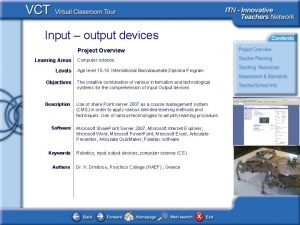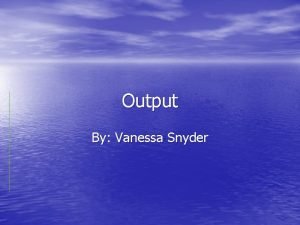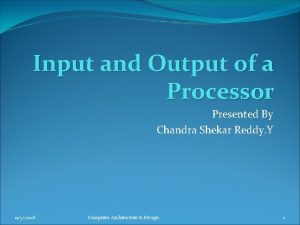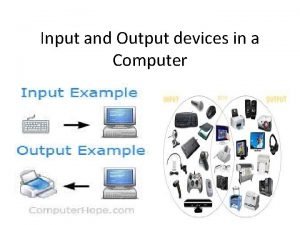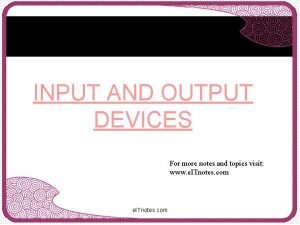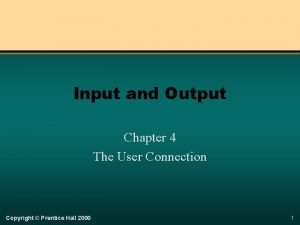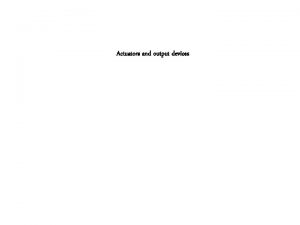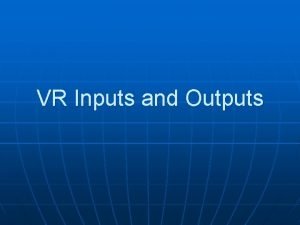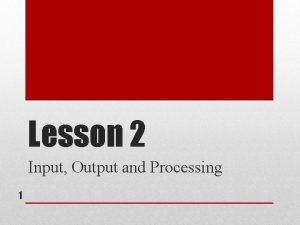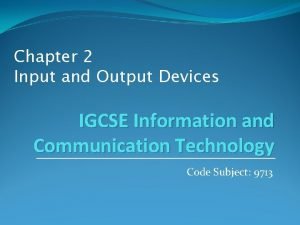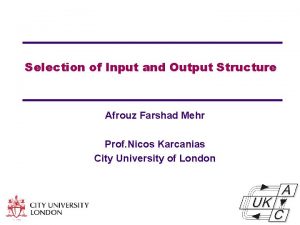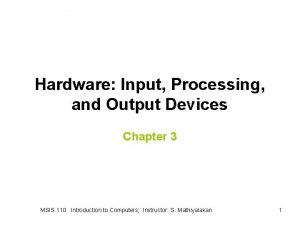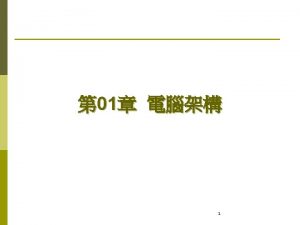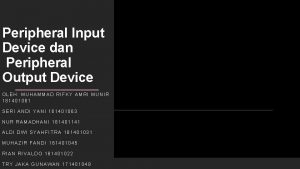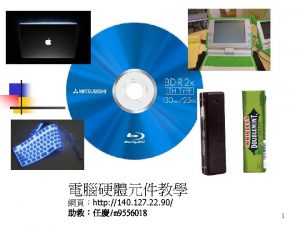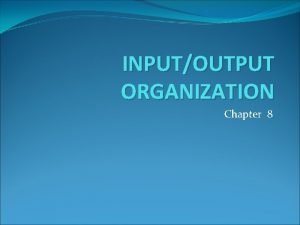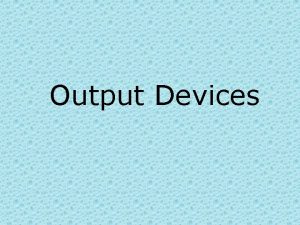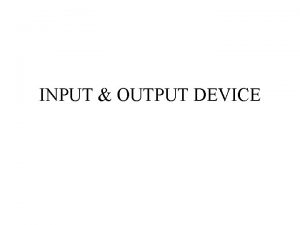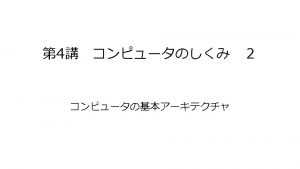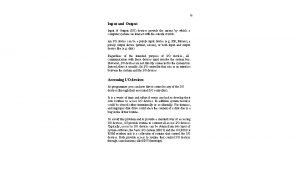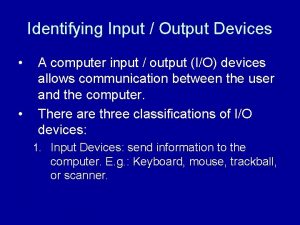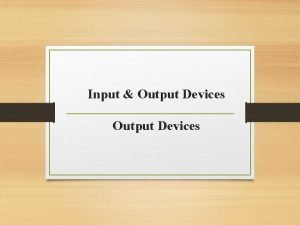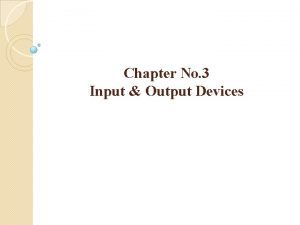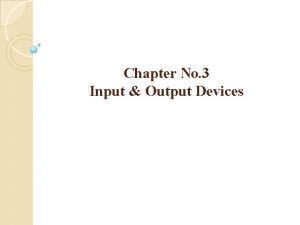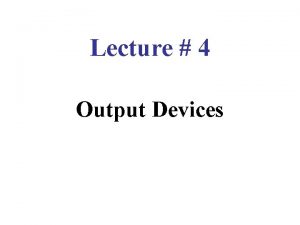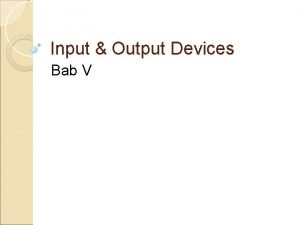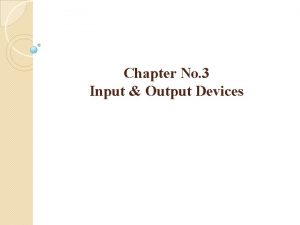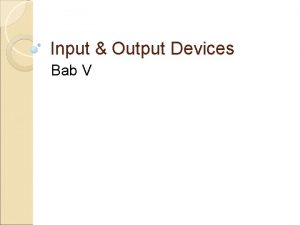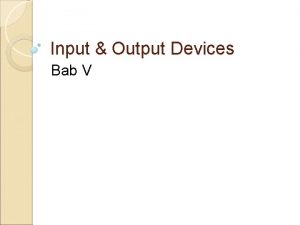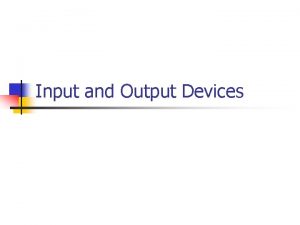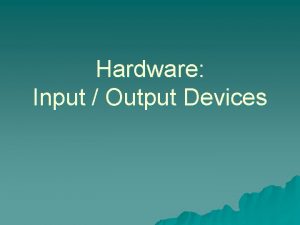Input output devices Project Overview Learning Areas Levels






















- Slides: 22

Input – output devices Project Overview Learning Areas Levels Computer science Age level 15 -18. International Baccalaureate Diploma Program Objectives The creative combination of various information and technological systems for the comprehension of Input Output devices Description Use of share Point server 2007 as a course management system (CMS) in order to apply various blended learning methods and techniques. Use of various technologies to amplify learning procedure. Software Keywords Authors Microsoft Share. Point Server 2007, Microsoft Internet Explorer, Microsoft Word, Microsoft Power. Point, Microsoft Excel, Articulate Presenter, Articulate Quiz. Maker, Parallax software Robotics, input output devices, computer science (CS) Dr. K. Dimitriou, Psychico College (HAEF) , Greece

Input – output devices Teacher planning Teacher Planning – Project description The design of the teaching methodology combines and integrates • teaching objectives • learning objectives • creation of an appealing and pleasant learning environment • linkage of theoretical framework with an empirical case study This learning project aims to develop an integrated learning framework for the computer science topic input and output devices The subject of research is whether blended learning surpasses conventional learning The use of technology is not an end in itself but the vehicle for integrated teaching

Input – output devices Teacher planning Teacher Planning – Project description Microsoft Share Point Server 2007 is an ideal content management system. This tool is used in this project as a course management system (CMS) to facilitate: • Direct access to learning resources • Interactive learning • Collaboration between students and teacher • Direct exchange of data and information • Evaluation and assessment through internet/intranet • Replacement of lost class hours due to illness, celebrations etc

Input – output devices Teacher Planning – Project description Teacher planning Lesson content • Keyboard • Mouse • Wimp • Graphics table • Light pen • Laser scanner • OMR • OCR • MICR • Automatic data entry • Sensors • Digital cameras • Speech recognition • Robotics • VDU • LCD • GDU • Printers • Plotters • Touch screens

Input – output devices Teacher Planning – Project description Input Output procedures –systematic approach Teacher planning Human or data collection Processing unit Input device Interface between human and device Processing unit Interface between input device and the processing unit Output device Interface Human Other device

Input – output devices Teacher planning Teacher Management – Teaching • During the first stage (stage 1) the students coped with input output methods and devices in the classroom. They also did some reading at home. • The power point was used for the lecture while students used internet explorer to gather additional information from various internet sites.

Input – output devices Teacher planning Teacher Management – Teaching During the next stage (2), 1. Students searched the WWW for additional information and then added their links to the CMS 2. Students solved their exercises and then saved them as word files in the CMS 3. Students used the team discussion of the CMS to solve their wonders and discuss about the lesson 4. Teacher evaluated the original and the final document of each student and published the right answers

Input – output devices Teacher Management – Teaching Teacher planning During the third stage students • Discussed their questions and answers with the teacher • Took a writing test

Input – output devices Teacher planning Teacher Management – Teaching The fourth stage is completely based on the CMS. 1. Students developed their tests with multiple choice, multiple response matching, fill in the blank, etc questions. Each student knew only the questions of his own word document. 2. Teacher chose questions from all tests and created with the Articulate Quizmaker software an on line test. Students had to take the test within a certain time period. 3. The software automatically marked the tests and the results plus the right answers were disseminated through the CMS.

Input – output devices Teacher planning Teacher Management – Teaching During the last stage (5) the Hex. Crawler Robot Kit and selected sensors were used in order to explore input output devices. • The Hex. Crawler Robot Kit is equipped with the Board of Education programming board suitable for training, education and research activities. • This part of the project is developed in parallel with the activities of the artificial intelligence and robotics club of Psychico College. • Students assemble, program and analyze the infraction of the robot with its environment. • The activities of the artificial intelligence and robotics club are exhibited to the college fair.

Input – output devices Teacher Management – Teaching PROJECT STAGES Teacher planning STAGE 1 STAGE 2 STAGE 3 STAGE 4 STAGE 5 Period Of Time Six Hours Weekend- Home Four Hours Two Hours. Home-School Continuous Process Emphasis Learning Collaboration Evaluation Learning Contribution To College Community

Input – output devices Teaching Resources • Teacher’s notes • Various books from the library • Some of WWW resources used • edweb. sdsu. edu/people/ARossett/eportfolio. asp • http: //data. webjunction. org/wj/documents/17236. pdf • http: //occ. ibo. org/ibis/occ/guest/home. cfm • http: //tlc. ucalgary. ca/documents/chuck. doc • ibcomp. fis. edu/ • www. 21 stcenturyskills. org/documents/Frameworkflyer 092806. pdf • www. hp. com/learn/microsoft • www. ib-computing. com • www. learningcircuits. org/2002/aug 2002/valiathan. html • www. microsoft. com/education/innovativeteachers. mspxwww. amanet. org/blende d/white-papers. htm • www. amanet. org/blended/white-papers. htm • www. microsoft. com/uk/education/schools/bsf • www. netg. com/News. And. Events/Press. Releases/view. asp? Press. ID=75 • www. parallax. com/Support/Downloads/tabid/477/Default. aspx • www. parliament. uk/edskills/ • www. pcd-innovations. com/index. htm • www. pfeiffer. com/legacy/features/jb/btp/index. html • www. teachernet. gov. uk/_doc/6094/BSF%20 Public%20 Launch%20 Document% 20 Feb%202004. pdf • www. unesco. org/en/competency-standards-teachers • www. webjunction. org/blendedlear. Ning • www. workforce. com/archive/feature/22/26/58/index. php

Input – output devices Teaching Resources The CS starting page (CMS)

Input – output devices Teaching Resources On line test (articulate software)

Input – output devices Teaching Resources Hex. Crawler Robot Kit and Board of education

Input – output devices Teaching Resources Sensors

Input – output devices Assessment & standards General evaluation • The students response was amazing. Students asked to adopt this methodology to all Computer Science modules. • The overall design of this activity favors all students, helps absent students and students with dyslexia or dysgrafia feel better and present a better performance. • According to recent publications, outcomes of international conferences and educational events (BETT 2007, 2008) the education seems to adopt such methodologies and activities.

Input – output devices Assessment & standards Teacher’s evaluation The evaluation of the overall activity was made with the following criteria: • Comprehension • Teaching efficiency • Participation • Enthusiasm • Collaboration • Motivation to improve The performance of this group of students to this module was compared using the above criteria against: • The group performance to the previous modules • The performance to this module of the previous CS groups The results were amazing and show the superiority of this approach.

Input – output devices Assessment & standards Student’s evaluation Students believe that this activity presents : • Combination of technology with learning • Direct and empirical application of their knowledge • Conversion of knowledge to experience and expertise • Dissemination of outcomes and results to the school community • Contribution to the school community with high quality educational material

Input – output devices Assessment & standards Evaluation-indirect benefits Besides the direct benefits for the students some indirect benefits came up during the process: • Contribution to the funds drive through the presentation of the robot at the College fair. • Facilitation of students interested in elaborating an Extended Essay in Computer Science. The IB students must complete an extended essay in specific cognitive field. • Development of collaboration communication and agreement among students. • Support team spirit among students • Simulation of academic environment • Rapid adjustment of any module to this methodology

Input – output devices Assessment & standards Ib standards All procedures followed in this project are compatible with the IB philosophy: IB- DIPLOMA PROGRAMME-COMPUTER SCIENCE- OBJECTIVES (IB, 2004) At the end of either the standard level (SL) or higher level (HL) computer science courses, students will be expected to fulfill the following objectives. 1. Demonstrate an understanding of: terminology, concepts, processes, structures, techniques, principles, systems and consequences (social significance and implications) of computing. 2. Apply and use: terminology, concepts, processes, structures, techniques, principles and systems of computing. 3. Analyze, discuss and evaluate: terminology, concepts, processes, structures, techniques, principles, systems and consequences (social significance and implications) of computing. 4. Construct: processes, structures, techniques and systems of computing.

Input – output devices Teacher and School Information A big thanks to my students and to my colleague D. Georgiou HAEF PSYCHICO COLLEGE 15 Stefanou Delta – 154 52 P. Psychico TEL: +30 210 67. 98. 207 FAX: +30 210 67. 56. 762
 Output and input devices of computer
Output and input devices of computer Purpose of output devices
Purpose of output devices Input and output devices project
Input and output devices project Vr input
Vr input What is output
What is output Input vs output devices
Input vs output devices Conclusion for input and output devices of computer
Conclusion for input and output devices of computer Touchpad input or output
Touchpad input or output Notes on output devices
Notes on output devices Input and output devices conclusion
Input and output devices conclusion Input device output device storage device
Input device output device storage device Is an actuator input or output
Is an actuator input or output Vr output devices
Vr output devices Input and output devices wiring for plc
Input and output devices wiring for plc _____ and _______are the basic output primitives.
_____ and _______are the basic output primitives. Keyboard mouse scanner and microphone are blank devices
Keyboard mouse scanner and microphone are blank devices Is chip and pin reader input or output
Is chip and pin reader input or output Conclusion of input and output devices
Conclusion of input and output devices Computer input and output devices
Computer input and output devices Input and output devices
Input and output devices Yang merupakan perangkat input device yaitu
Yang merupakan perangkat input device yaitu Input output memory
Input output memory Accessing input output devices
Accessing input output devices


